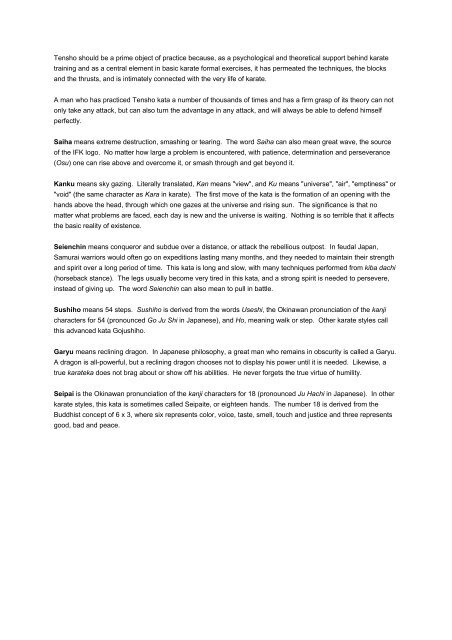Sosai Mas Oyama Sosai (President) - Haugesund Kyokushin Karate ...
Sosai Mas Oyama Sosai (President) - Haugesund Kyokushin Karate ...
Sosai Mas Oyama Sosai (President) - Haugesund Kyokushin Karate ...
Create successful ePaper yourself
Turn your PDF publications into a flip-book with our unique Google optimized e-Paper software.
Tensho should be a prime object of practice because, as a psychological and theoretical support behind karate<br />
training and as a central element in basic karate formal exercises, it has permeated the techniques, the blocks<br />
and the thrusts, and is intimately connected with the very life of karate.<br />
A man who has practiced Tensho kata a number of thousands of times and has a firm grasp of its theory can not<br />
only take any attack, but can also turn the advantage in any attack, and will always be able to defend himself<br />
perfectly.<br />
Saiha means extreme destruction, smashing or tearing. The word Saiha can also mean great wave, the source<br />
of the IFK logo. No matter how large a problem is encountered, with patience, determination and perseverance<br />
(Osu) one can rise above and overcome it, or smash through and get beyond it.<br />
Kanku means sky gazing. Literally translated, Kan means "view", and Ku means "universe", "air", "emptiness" or<br />
"void" (the same character as Kara in karate). The first move of the kata is the formation of an opening with the<br />
hands above the head, through which one gazes at the universe and rising sun. The significance is that no<br />
matter what problems are faced, each day is new and the universe is waiting. Nothing is so terrible that it affects<br />
the basic reality of existence.<br />
Seienchin means conqueror and subdue over a distance, or attack the rebellious outpost. In feudal Japan,<br />
Samurai warriors would often go on expeditions lasting many months, and they needed to maintain their strength<br />
and spirit over a long period of time. This kata is long and slow, with many techniques performed from kiba dachi<br />
(horseback stance). The legs usually become very tired in this kata, and a strong spirit is needed to persevere,<br />
instead of giving up. The word Seienchin can also mean to pull in battle.<br />
Sushiho means 54 steps. Sushiho is derived from the words Useshi, the Okinawan pronunciation of the kanji<br />
characters for 54 (pronounced Go Ju Shi in Japanese), and Ho, meaning walk or step. Other karate styles call<br />
this advanced kata Gojushiho.<br />
Garyu means reclining dragon. In Japanese philosophy, a great man who remains in obscurity is called a Garyu.<br />
A dragon is all-powerful, but a reclining dragon chooses not to display his power until it is needed. Likewise, a<br />
true karateka does not brag about or show off his abilities. He never forgets the true virtue of humility.<br />
Seipai is the Okinawan pronunciation of the kanji characters for 18 (pronounced Ju Hachi in Japanese). In other<br />
karate styles, this kata is sometimes called Seipaite, or eighteen hands. The number 18 is derived from the<br />
Buddhist concept of 6 x 3, where six represents color, voice, taste, smell, touch and justice and three represents<br />
good, bad and peace.


